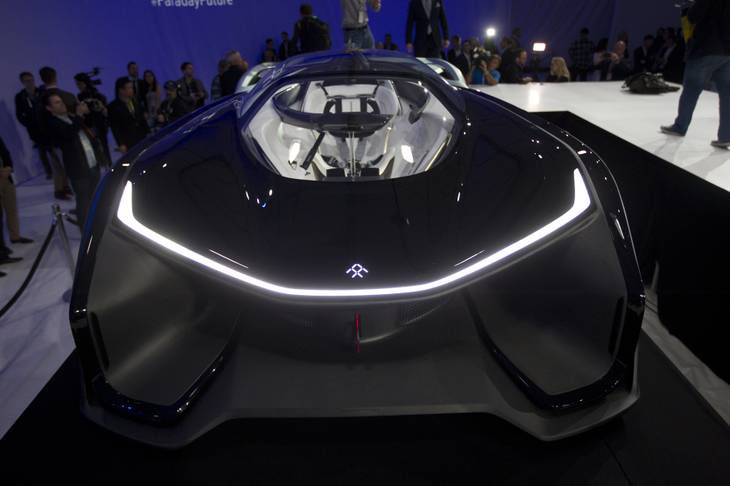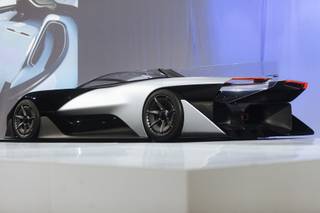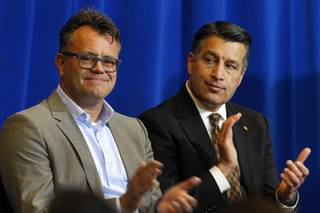Related news
Faraday Future pledges to redefine mobility. It has hinted at offering an Uber-like service and producing cars that operate autonomously. It’s a company that vows to sell an electric car in two years that changes our relationship with driving.
But when the company, linked to a Chinese-billionaire who emulates Steve Jobs, unveiled a high-end concept car Monday night as the first tangible look into its plans, observers were still left struggling to assess Faraday’s ability to bring a vehicle to the mass market. As the company promised, its concept car was far from an anodyne vehicle, geared to appeal to a large swath of customers and made for everyday travel.
Faraday’s car resembled more of an enthusiast's toy. It’s a one-seat sports car, dubbed FFZERO1, that boasts 1,000 horsepower, a carbon-fiber finish, a driver seat tilted at a 45-degree angle, aerodynamic air-ducts, four motors taking it up to 200 miles per hour and a smartphone inside the steering wheel for live images.
“It’s a very dramatic concept, as many concepts are,” said Bruce Belzowski, the managing director of the Automotive Futures Group at a University of Michigan transportation institute.
But he added: “We’re really interested in the production vehicle.”
Faraday’s concept car is not the production car. Tim Stevens, a CNET editor who will be launching an automotive vertical in the coming weeks, said Faraday would have to price the concept car at a level that would put it out of range for all but the wealthiest consumers. By his estimate, the window-sticker price of the FFZERO1 would be more than $1 million.
Instead, it is “an amplified version of the design and engineering philosophies informing (Faraday’s) forthcoming production vehicles,” as Richard Kim, Faraday’s head of design, said in a news release Monday.
With no production car at Faraday’s highly anticipated pre-CES news conference, which was attended by state officials who helped put together a $335 million incentive package to get the company to build a $1 billion factory in North Las Vegas, the auto industry was left with Faraday’s ideas, the technology that will support its eventual car.
And some of the ideas are original. “It’s very different from what we’ve heard from other companies,” Belzowski said of some of Faraday’s ideas, which could set the company apart when it produces a car.
The Sun looked at some of the technology involved and questions that remain about the production car.
During the company’s presentation last night, Faraday’s top executives attempted to set its product apart from the competition by arguing that it represented an improved electric car in the following ways:
Battery strings: The car is built upon a battery pack that is separated into strings of batteries rather than existing as a single pack. That means batteries can be easily changed without replacing the entire pack. A Faraday official likened this to Christmas lights arranged in a parallel circuit — one lightbulb dying does not affect the entire system. The battery strings also allow Faraday to vary the size of its cars more easily.
Vehicle modification: Faraday touts a modular design system, specifically for electric vehicles, that it calls a Variable Platform Architecture. With it, Kim said, Faraday could produce nearly any type of car from a flexible chassis that can be made shorter or longer. The modular design, which Faraday says could help cut costs, also allows for up to four electric motors while offering an array of power and range options.
Personalization: Calling its car a “tablet on wheels,” the firm has long argued that it was building a piece of technology rather than only a vehicle to go from Point A to B. The car unveiled last night brought more clarity to that vision by including a smartphone in the steering wheel. With enhanced connectivity, Faraday said it could personalize vehicle configuration and give drivers access to real-time data and live image feeds.
“They really want to make a car that increases in value,” Stevens said. “The idea Faraday is going for is they want cars that are a lot more personalized, smarter about you, your driving habits and your needs. A big part of that is interaction with your smartphone.”
Personalization is part of an industry trend to better integrate cars with everyday life. A smart car, for instance, could know when to open the garage or turn on the air conditioning in a home when a driver gets near.
Despite the technology Faraday unveiled Monday night, several questions remain.
Redefining mobility: A primary goal of Faraday’s is to create a new generation of mobility, which would suggest movement that does not revolve around personally owned and operated cars. In the past, the company has suggested an Uber-like sharing system. During the Monday presentation, Faraday did not elaborate on that aspect of their business model. And while the company said their concept car could be fully autonomous, officials did not specify on what level of autonomy their production car would have.
A mass-market car: To many who watched, including Stevens, the most interesting question was whether the company will be able to create an affordable car that can compete with other carmakers. Faraday has hired hundreds of employees from tech giants like Google, SpaceX, Tesla and Apple. It also has financial backing, partnering with LeTV, a firm known as the Chinese Netflix. Stevens said without seeing a more practical concept car or the production car, it was difficult to determine how successful Faraday would be.
“That’s the big thing we were hoping to see (on Monday),” Stevens said. “And we did not see that.”


